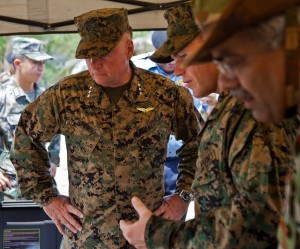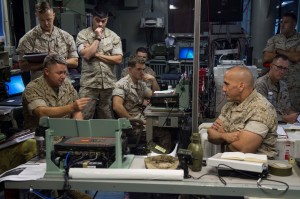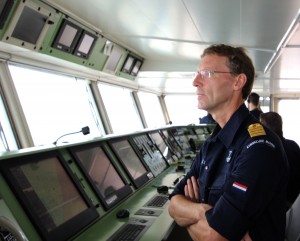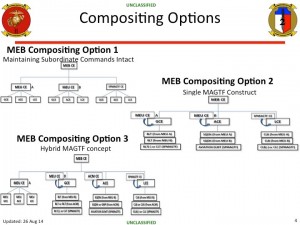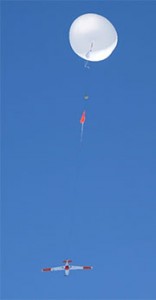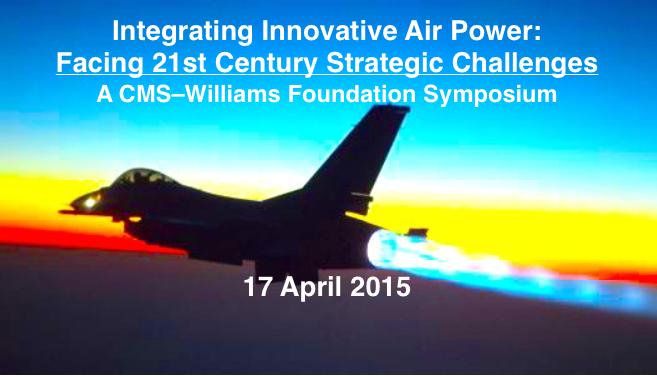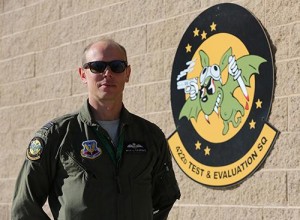2015-04-20 By Robbin Laird
During my visit to 2d MEB (Marine Expeditionary Brigade), I had the opportunity to interview Major General Richard L. Simcock II, Commanding General, 2d MEB, and Major Marcus Mainz, lead 2d MEB planner for Exercise Bold Alligator 2014, where we had a lengthy discussion regarding the Marine Corps’ innovative approach in addressing Combatant Commanders’ requirements.
During the interviews, I was able to discuss 2d MEB innovations in C2 (command and control) with Mainz.
Although we discussed many aspects of the 2d MEB’s approach to C2 for Marine Corps composited forces, the innovations evident in Bold Alligator provided several concrete examples of how 2d MEB is working through emerging C2 challenges.
Innovations in aviation allow Marines to extend their reach and provide greater flexibility for amphibious operations. The reworking of the amphibious fleet to deliver capabilities to project power from the sea and the ability of the infantry to implement innovations in maneuver warfare and force insertion require creativity in operational design and C2.
The very term command and control can be confusing because it suggests top-down control of detailed operational activities.
However, 2d MEB exercises C2 of scalable and modular forces by delegating it to a level where tactical operations are more effective.
This contradicts a growing trend of micromanagement of an expanding battlespace.
This construct facilitates mastery of the operational environment in a fluid combat situation by keeping focus at the appropriate levels. It gives the MEB CE (command element) the capability to focus on the operational art that bridges the strategic and tactical levels for political objectives.
Execution of the mission, empowerment of subordinate leaders at the appropriate level, and maintaining situational awareness of the overall situation is a key challenge for C2.
The complexity begins with incorporation of joint and coalition forces for CJTF operations.
Given that joint and coalition capabilities enhance response time and effectiveness of global operations, C2 takes on a whole new meaning when shaping the appropriate composite force for missions across the ROMO (Range of Military Operations), which makes it central to effective Marine Corps Operations.
2d MEB is hard at work on meeting this challenge.
MajGen Simcock explained in his interview that the importance of “providing the Combatant Commander with a force capable of plugging into various joint, coalition, and interagency requirements is essential. The realities of the 21st century security environment demand a smart power approach inclusive of all services of the military, our partners and interagencies, which play an integral role in fulfilling National Security Strategy.”
Integration of allied and partner nation operational capabilities and systems with the U.S. amphibious fleet will develop, in effect, a global U.S.-Allied amphibious fleet capability.
General Simcock also discussed emerging demand for partnership with 2d MEB in global security “since the Marine Corps has revitalized the MEB concept capable of world-wide deployment, we have been contacted by many of our coalition partners, allies and other nations interested in training and operating with 2d MEB.”
The way Major Mainz explained it:
Composite forces are created when you take disparate forces, which are underneath different command and control structures, and place them underneath one commander tasked with a specific mission.
The 2d Marine Expeditionary Brigade is ‘a receiver of forces.’ We work various compositing options and shape the C2 for those forces coming together to perform the mission.
Major Mainz likened the 2d MEB CE to a Swiss army knife.
We want to be the Swiss Army knife of command and control.
We want to morph or adapt into whatever environment we’re in – coalition or joint.
2d MEB sees itself as a scalable CE capable of C2 for disparate forces, coalition and/or joint, to address the unique requirements of Combatant Commanders in uncertain environment.
The emphasis is upon shaping the force appropriate to the mission much as I discussed earlier the concept of insertion forces.
“We’re not trying to deploy something forward that’s not needed.”
Major Mainz explained the planning approach.
2d MEB needs three things to create a plan – battlespace, mission, and troops available, but given any of the two we develop the third. We offer the Combatant Commander a scalable force capable of operations across the ROMO.
This mental concept allows us to avoid a preconceived notion of what a C2 structure should look like.What makes us so different from any other Command Element is our lack of prearranged subordinate forces along with a training program rehearsing different C2 structures.
We have the mental flexibility to design a plan tailor-made to the unique mission and battlespace of any Combatant Command.
Exercise Bold Alligator 2014 was clearly about C2 and shaping a force that can work with coalition forces operating under a foreign commander.
“The unique term we used during Bold Alligator is we can become a Commander of MAGTFs, not a MAGTF Commander. What that means is we see our Command Element as so flexible we don’t have to go into a normal Marine construct.”
The Marines exercised C2 of multiple U.S. and coalition led MAGTFs while organizing additional structure to support them.
This mix and match approach was a crucial element of what was tested in Bold Alligator 2014.
For example, in Bold Alligator we used the T-AKE (Dry Cargo/Ammunition Ship) as a logistics combat element ship.
We had three different MAGTF’s involved but separately we had a logistics combat element operating off a T-AKE, an intermediate staging base and a land base.
We were trying to show the flexibility that we can mix and match whatever the situation actually demands. We don’t need one model or the other, we can create hybrid models.
Major Mainz explained how this approach worked with the Dutch who were in charge of a coalition operation.
When the Dutch did a raid during the operation, Marine Corps’ Aviation supported their raid.
And this required not only flexibility, but clear command and control relationships when those Marine Corps aviation forces were chopped to the Dutch during that mission.
One of the challenges faced in doing coalition C2 is the security restriction on the U.S. side, which is a key part of shaping effective joint C2.
When we provided them an American ship, American helicopters, and some Marines and said you’re in charge of that task force, we spent an enormous amount of time creating what they called command knee boards, to determine what can we ask of the coalition force.
During this intellectual rigor we realized the U.S. had information that was difficult to share in the original construct.
Our challenge was determining how to share relevant information within the constraint of the communications architecture.
We spent an inordinate amount of time getting it to a metric where we could share with the coalition.
Another aspect of the exercise was the USS Kearsarge the installation of CENTRIXS servers to handle coalition communications.
According to Major Mainz, those servers remained on the ship.
“The Kearsarge is now a coalition communications ship.”
In effect, Bold Alligator 2014 was not an exercise; “it was a mission rehearsal.”
A major effort developed from the need to communicate with coalition partners – the need to work on what the Major referred to as building an “information kiosk.”
The challenge was to shape ways to effectively exchange information.
How do we move things from SIPR net to CENTRIXS?
How do we transfer from NIPR net to CENTRIXS?
We dedicated significant manpower and intellectual rigor to these processes?
Major Mainz also discussed the execution of a flexible, scalable and an apportioned HQ for amphibious shipping and/or coalition and joint operations, another important aspect of C2 innovation during Bold Alligator 2014.
One of the things we did during Bold Alligator was to leave the majority of our force at Camp Lejeune as a reachback capability for the command element while we went out on the ships.
On average, MEB amphibious operations necessitate a two hundred man staff. We never put more than seventy people on that ship because we were testing our reachback capabilities.
The general says, ‘Get there the fastest with the mostest.’ Get out there, and get out there fast.
I don’t need to bring everything with me, bring just enough to be capable.
In short, C2 of a composited force is about flexible insertion appropriate to the mission, given its restraints, able to operate from land, air and the sea – not simply park forces on land.
It is about modularity; it is about scalability; and it is about pushing C2 to the appropriate level of decision-making.
And 2d MEB is hard at work on these 21st century innovations.
For earlier pieces on C2 and Bold Alligator 2014, see the following:
http://sldinfo.wpstage.net/re-shaping-coalition-insertion-forces-bold-alligator-2014/
And see the following USMC document as well:
Expeditionary Force 21, which provides a concept for the Marine Corps (MC) to build, equip and train their forces for 21st century operations.
The MC is enabled by the US Navy (USN) amphibious fleet, which is equipped and trained for the ROMO (Range of Military Operations).
To do so, the Marines are focusing on evolving their capabilities beyond the PHIBRON (Amphibious Squadron) or ARG (Amphibious Ready Group)/MEU (Marine Expeditionary Unit) level by bringing forces together from across the theater of operations to composite forces.
The goal is to “provide timely and scalable forces for crisis response, allowing commanders to tailor forces to evolving missions and effectively composite modular MAGTFs (Marine Air Ground Task Forces) by combining forward-deployed forces with rapidly deploying forces.”


